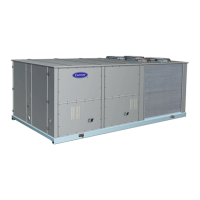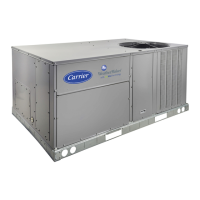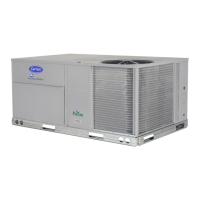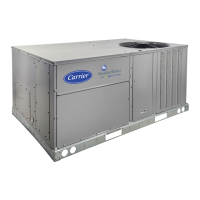69
The configurable fire speed override for supply fan VFD is in
Configuration
SP
SP.FS.
The supply fan relay’s commanded output can be found in Out-
puts
FANS
S.FAN.
The supply fan VFD’s commanded speed can be found in Out-
puts
FANS
S.VFD.
Indoor Air Quality Control
The indoor air quality (IAQ) function will admit fresh air into
the space whenever space air quality sensors detect high levels
of CO
2
.
When a space or return air CO
2
sensor is connected to the unit
control, the unit’s IAQ routine allows a demand-based control
for ventilation air quantity, by providing a modulating outside
air damper position that is proportional to CO
2
level. The ven-
tilation damper position is varied between a minimum ventila-
tion level (based on internal sources of contaminants and CO
2
levels other than from the effect of people) and the maximum
design ventilation level (determined at maximum populated
status in the building). Demand controlled ventilation (DCV) is
also available when the ComfortLink unit is connected to a
CCN system using ComfortID™ terminal controls.
This function also provides alternative control methods for
controlling the amount of ventilation air being admitted, in-
cluding fixed outdoor air ventilation rates (measured as cfm),
external discrete sensor switch input and externally generated
proportional signal controls.
The IAQ function requires the installation of the factory- op-
tion economizer system. The DCV sequences also require the
connection of accessory (or field-supplied) space or return air
CO
2
sensors. Fixed cfm rate control requires the factory- in-
stalled outdoor air cfm option. External control of the ventila-
tion position requires supplemental devices, including a 4 to 20
mA signal, a 10,000 ohms potentiometer, or a discrete switch
input, depending on the method selected. Outside air CO
2
lev-
els may also be monitored directly and high CO
2
economizer
restriction applied when an outdoor air CO
2
sensor is connect-
ed. (The outdoor CO
2
sensor connection requires installation of
the CEM.)
The ComfortLink control system has the capability of DCV using
an IAQ sensor. The indoor air quality (IAQ) is measured using a
CO
2
sensor whose measurements are displayed in parts per mil-
lion (ppm). The IAQ sensor can be field-installed in the return
duct. There is also an accessory space IAQ sensor that can be in-
stalled directly in the occupied space. The sensor must provide a 4
to 20 mA output signal and must include its own 24-v supply. The
sensor connects to terminal TB5-6 and 7. Be sure to leave the
182-ohm resistor in place on terminals 6 and 7.
OPERATION
The unit’s indoor air quality algorithm modulates the position
of the economizer damper between two user configurations de-
pending upon the relationship between the IAQ and the out-
door air quality (OAQ). Both of these values can be read at the
Inputs
AIR.Q submenu. The lower of these two configu-
rable positions is referred to as the IAQ Demand Vent Min Po-
sition (IAQ.M), while the higher is referred to as Economizer
Minimum Position (EC.MN). The IAQ.M should be set to an
economizer position that brings in enough fresh air to remove
contaminants and CO
2
generated by sources other than people.
The EC.MN value should be set to an economizer position that
brings in enough fresh air to remove contaminants and CO
2
generated by all sources including people. The EC.MN value is
the design value for maximum occupancy.
The logic that is used to control the dampers in response to
IAQ conditions is shown in Fig. 13. The ComfortLink controls
will begin to open the damper from the IAQ.M position when
the IAQ level begins to exceed the OAQ level by a configu-
rable amount, which is referred to as Differential Air Quality
Low Limit (DAQ.L).
If OAQ is not being measured, OAQ can be manually config-
ured. It should be set at around 400 to 450 ppm or measured
with a handheld sensor during the commissioning of the unit.
The OAQ reference level can be set using the OAQ Reference
Setpoint (OAQ.U). When the differential between IAQ and
OAQ reaches the configurable Diff. Air Quality Hi Limit
(DAQ.H), then the economizer position will be EC.MN.
When the IAQ–OAQ differential is between DAQ.L and
DAQ.H, the control will modulate the damper between IAQ.M
and EC.MN as shown in Fig. 13. The relationship is a linear re-
lationship but other non-linear options can be used. The damp-
er position will never exceed the bounds specified by IAQ.M
and EC.MN during IAQ control.
If the building is occupied and the indoor fan is running and the
differential between IAQ and OAQ is less than DAQ.L, the
economizer will remain at IAQ.M. The economizer will not
close completely. The damper position will be 0 when the fan
is not running or the building is unoccupied. The damper posi-
tion may exceed EC.MN in order to provide free cooling.
The ComfortLink controller is configured for air quality sen-
sors which provide 4 mA at 0 ppm and 20 mA at 2000 ppm. If
a sensor has a different range, these bounds must be reconfig-
ured. These pertinent configurations for ranging the air quality
sensors are IQ.R.L, IQ.R.H, OQ.R.L and OQ.R.H. The bounds
represent the PPM corresponding to 4 mA (low) and 20 mA
(high) for IAQ and OAQ, respectively.
If OAQ exceeds the OAQ Lockout Value (OAQ.L), then the
economizer will remain at IAQ.M. This is used to limit the use
of outside air which outdoor air CO
2
levels are above the
OAQ.L limit. Normally a linear control of the damper vs. the
IAQ control signal can be used, but the control also supports
non-linear control. Different curves can be used based on the
Diff.AQ Responsiveness Variable (IAQ.R). See Fig. 14.
100
500
700
1000
INSIDE/OUTSIDE CO
2
DIFFERENTIAL
INSIDE CO
2
CONCENTRATION
AQ
DIFFERENTIAL
LOW (DAQ.L)
AQ
DIFFERENTIAL
HIGH (DAQ.H)
MINIMUM
IAQ
DAMPER
POSITION
ECONOMIZER
MINIMUM
DAMPER
POSITION
INCREASING VENTILATION
VENTILATION FOR PEOPLE
VENTILATION FOR SOURCES

